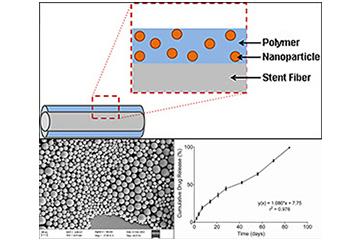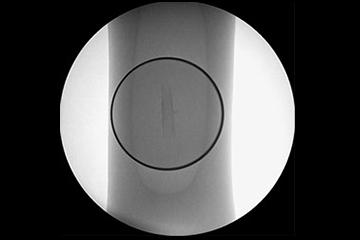The lab has a primary interest in developing materials and medical devices for use in treatment of congenital heart disease. Most medical devices for pediatrics are derived from devices developed for adult patients. Congenital heart disease patients in general require the use of bioresorbable materials because they degrade in the body as the patient grows.
The Welch Lab has made advances in treatment of aortic coarctation, pulmonary artery stenosis, and tracheomalacia in pig models using bioresorbable stent technology. Limitations on bioresorbable materials used in adult and congenital heart disease has led my lab to developed a new class of radiopaque bioresorbable polymers. This new class of bioresorbable materials has sparked interest with other collaborators, including coating applications for drug delivery carriers for cancer treatment, theranostic nanoparticle treatment, and composite coating systems for multidrug delivery. Structural applications of these polymers may be used for bioresorbable conduits, IVC filters, heart valves, heart patches, and skin grafts. My lab has interest in translating medical devices to fulfill “unmet clinical needs” by combining the use of experimental and in-silico computational simulation.
Project 1 - Development of Composite Bioresorbable Coatings for Tracheomalacia
Research Aspect- Tracheomalacia is characterized by flaccidity of the airway whereby tracheal collapse occurs during respiration. Globally, approximately 1:21 children are affected by airway malacia whether it be acquired or from congenital origins. Of the available modalities of treatment, stenting has the greatest potential for success but remains controversial in pediatrics due to limitations in biocompatibility and internal reinforcement. This research shows the development of a MRI-visible multi-drug release composite coating that is to be applied to a bioresorbable stent.
 Drug Release
Drug Release Project 2 - Mimetic Fluoroscopic Bioresorbable Polymers for Cardiac Patches
Research Aspect- The most prevalent congenital heart defect requiring surgical repair is a ventricular septal defect allowing shunting of blood from the left to right ventricles, which occurs in 37.8 of every 10,000 live births. In addition to septal defects, cyanotic heart defects in which blood bypasses the lungs are potential targets for new materials.
Materials used for patching of cardiac defects include various forms of knitted polyester (most commonly Dacron), expanded polytetrafluoroethylene (such as Gore-Tex®), and autologous and bovine pericardium. However, these materials have limitations including the inability to grow with the patient’s heart, loss of mechanical strength over time, limited ability to remodel/ regenerate, and increased risk of infection and aneurysm. Currently, the patch materials used clinically are limited to prosthetic materials, autologous pericardium and allogenic or xenogenic(glutaraldehydefixed) pericardium. We are investigating a novel bioresorbable fluoroscopic polymer, poly(glycerol sebacate fumarate) gadodiamide (PGSF).
 Fluoroscopic Visible Film
Fluoroscopic Visible Film Project 3 - CO2 Foaming of PLLA Fibers
Research Aspect- Bioresorbable stents with limited functional lifetimes and with drug delivery capabilities are desired. Various methods have been investigated to induce porosity in bioresorbable polymeric stent fibers, thereby to permit increased drug reservoir capacity versus polymer-coated metal stents. In collaboration with UNT, we developed microporous surface layers and cores on PLLA fibers to serve as the drug reservoir, but found that impurities, the use of chemicals, and multiple step procedures associated with our and other published methods limited utility. Thus we investigated theoretically attractive CO2 blowing methods, in which gas under pressure and temperature induces porosity.
Project 4 - Mechanical and Thermal Analysis of Porcine Pericardium Fixation for Artificial Heart Valves
Research Aspect- Biological tissue constructs have been used for heart valve devices in pediatric patients. Tissue fixation has been performed using glutaraldehyde stabilization. Glutaraldehyde stabilization of the collagen structure (note: glutaraldehyde crosslinks collagen) prevents tissue digestion by enzymes and reduces the antigenicity of the material. Both bovine and porcine valves have been used for heart valve replacement.
Many fixation techniques have been investigated with glutaraldehyde with cross-linking agents to fixation processes such as freeze drying, photochemical fixation, microwave irradiation, and dynamic pulse fixation. This study investigates the mechanical and thermal properties of the standard use for fixation of porcine pericardium tissue in 1.3% and 0.5% phosphate buffered glutaraldehyde (GF) for different fixation times.
Project 5 - Image Reconstruction and 3D-Printing Patient-Specific Bioresorbable Polymer-Scaffolds
Research Aspect- In collaboration with UT Arlington, Dr. Shiakolas, we have built a 3D BioPrinter for printing 3D features using biodegradable polymers such as poly-L-lactide (PLLA) that is currently used for stents. Computer Tomography (CT) from DICOMM data and Computer Aided Design software are used for image reconstruction to print a foundation of different 3D structures. We are exploring a novel development of 3D printing for curved surfaces and flat surfaces to shape similar to heart patches and conduits for congenital heart disease using our novel bioresorbable fluoroscopic polymer, PGSF.
Project 6 - Bioresorbable Stents for Congenital Heart Disease
Research Aspect- Stent angioplasty has evolved the treatment of both congenital and adult heart disease. Conventional bare-metal and drug-eluting stents have excellent short-term results but are plagued with long-term thrombosis and restenosis. The focus of research into biodegradable materials and stent designs has been ongoing since the early 1990s. We have research with a novel biodegradable stent to potentially treat congenital heart disease in coarctation models and pulmonary models by investigating experimentally and finite element simulation.
 Stented Artery FEA Model
Stented Artery FEA Model